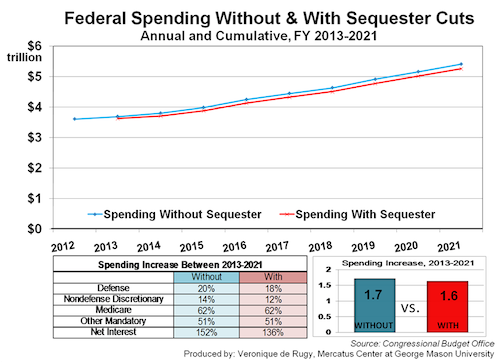September 15, 2012

Sequestration Cuts....aren't
Veronique de Rugy (h/t) explains the supposed "cuts" in sequestration:
The sequester is an automatic budget enforcement mechanism triggered when the Joint Select Committee on Deficit Reduction fails to enact legislation to reduce the deficit by $1.2 trillion over the sequestration period. Instead of simply passing appropriated funds to the agencies, the U.S. Treasury “sequesters” the difference between the cap set in the BCA and the amount appropriated.So don't believe the hype from government, contractors or others. There will still be more borrowed money for everyone. Ain't that just great?Changes in spending from sequestration result in new budget projections below the CBO’s baseline projection of spending based on current law. The federal government would spend $3.62 trillion in the first year with sequestration versus the $3.69 trillion projected by CBO. By 2021, the government would spend $5.26 trillion versus the $5.41 trillion projected. Overall, without a sequester, federal spending would increase $1.7 trillion (blue line). With a sequester, federal spending would increase by $1.6 trillion (red line).
While the sequester projections are nominal spending increases, most budget plans count them as cuts. Referring to decreases in the rate of growth of spending as “cuts” influences public perceptions about the budget. When the public hears “cut,” it thinks that spending has been significantly reduced below current levels, not that spending has increased. Thus, calling a reduced growth rate of projected spending a “cut” leads to confusion, a growing deficit, and an ever-larger burden for future generations.




 About Community Crier
About Community Crier

 About Engaged Citizen
About Engaged Citizen Administrator
Administrator




And what's frustrating is that both sides of the aisle use that confusion to intentionally mislead people. The next time some conservative tells me that "defense" spending under Obama is being gutted or some liberal claims entitlement spending is being slashed, I fear I'm going to cause them serious distress.
Posted by: jgardner at September 15, 2012 12:07 PM